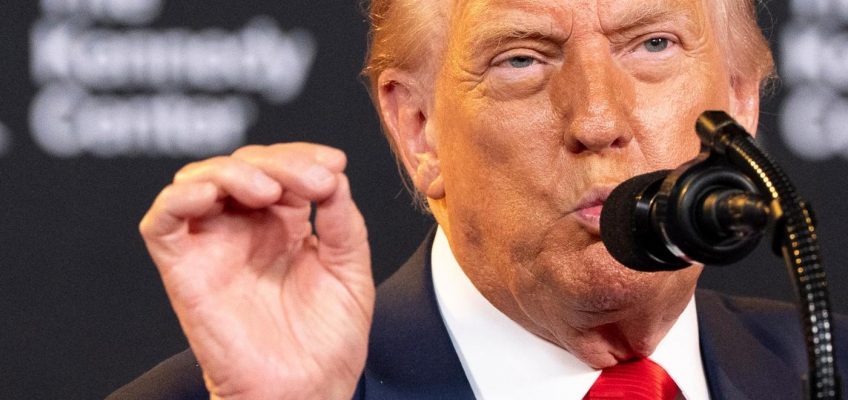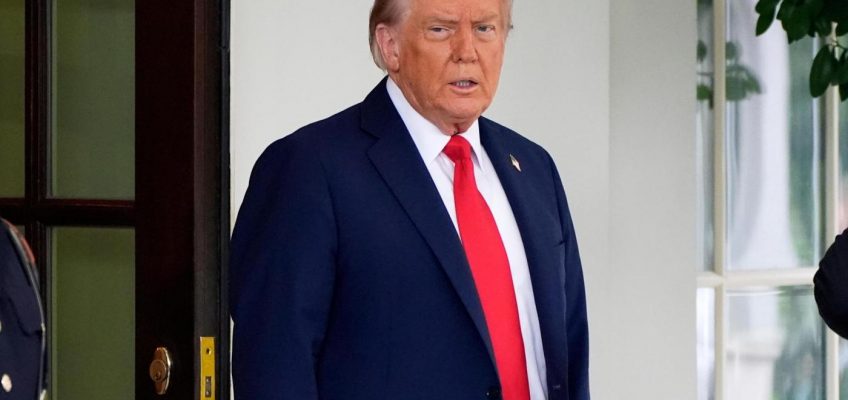By CHINEDU ASADU and MELISSA GOLDIN
President Donald Trump has projected himself as a peacemaker since returning to the White House in January, touting his efforts to end global conflicts.
Related Articles
Sen. Lindsey Graham says Trump ready to ‘crush’ Russian economy if Putin avoids talks with Zelenskyy
Trump administration vying to own a big stake in Intel after SoftBank’s $2 billion bet on company
Trump administration revokes security clearances of 37 current and former government officials
Trump’s Justice Department is investigating whether DC police officials falsified crime data
Mexico says there’s no agreement with DEA for new border enforcement collaboration
In meetings with Ukrainian President Volodymyr Zelenskyy and other European leaders Monday, Trump repeated that he has been instrumental in stopping multiple wars but didn’t specify which.
“I’ve done six wars, I’ve ended six wars, Trump said in the Oval Office with Zelenskyy. He later added: “If you look at the six deals I settled this year, they were all at war. I didn’t do any ceasefires.”
He raised that figure Tuesday, telling “Fox & Friends” that “we ended seven wars.”
But although Trump helped mediate relations among many of these nations, experts say his impact isn’t as clear cut as he claims.
Here’s a closer look at the conflicts.
Israel and Iran
Trump is credited with ending the 12-day war.
Israel launched attacks on the heart of Iran’s nuclear program and military leadership in June, saying it wanted to stop Iran from building a nuclear weapon — which Tehran has denied it was trying to do.
Trump negotiated a ceasefire between Israel and Iran just after directing American warplanes to strike Iran’s Fordo, Isfahan and Natanz nuclear sites. He publicly harangued both countries into maintaining the ceasefire.
FILE – People take pictures of smoke rising from an Israeli strike in Tehran, Iran, June 23, 2025. (AP Photo, File)
Evelyn Farkas, executive director of Arizona State University’s McCain Institute, said Trump should get credit for ending the war.
“There’s always a chance it could flare up again if Iran restarts its nuclear weapons program, but nonetheless, they were engaged in a hot war with one another,” she said. “And it didn’t have any real end in sight before President Trump got involved and gave them an ultimatum.”
Lawrence Haas, a senior fellow for U.S. foreign policy at the American Foreign Policy Council who is an expert on Israel-Iran tensions, agreed the U.S. was instrumental in securing the ceasefire. But he characterized it as a “temporary respite” from the ongoing “day-to-day cold war” between the two foes that often involves flare-ups.
Egypt and Ethiopia
This could be described as tensions at best, and peace efforts — which don’t directly involve the U.S. — have stalled.
The Grand Ethiopian Renaissance Dam on the Blue Nile River has caused friction between Ethiopia, Egypt and Sudan since the power-generating project was announced more than a decade ago. In July, Ethiopia declared the project complete, with an inauguration set for September.
Egypt and Sudan oppose the dam. Although the vast majority of the water that flows down the Nile originates in Ethiopia, Egyptian agriculture relies on the river almost entirely. Sudan, meanwhile, fears flooding and wants to protect its own power-generating dams.
During his first term, Trump tried to broker a deal between Ethiopia and Egypt but couldn’t get them to agree. He suspended aid to Ethiopia over the dispute. In July, he posted on Truth Social that he helped the “fight over the massive dam (and) there is peace at least for now.” However, the disagreement persists, and negotiations between Egypt, Ethiopia and Sudan have stalled.
“It would be a gross overstatement to say that these countries are at war,” said Haas. “I mean, they’re just not.”
India and Pakistan
The April killing of tourists in Indian-controlled Kashmir pushed India and Pakistan closer to war than they had been in years, but a ceasefire was reached.
Trump has claimed that the U.S. brokered the ceasefire, which he said came about in part because he offered trade concessions. Pakistan thanked Trump, recommending him for the Nobel Peace Prize. But India has denied Trump’s claims, saying there was no conversation between the U.S. and India on trade in regards to the ceasefire.
FILE – Indian security officers patrol in armored vehicles in Pahalgam, Indian controlled Kashmir, on April 22, 2025, after assailants indiscriminately opened fired at tourists. (AP Photo/Dar Yasin, File)
Although India has downplayed the Trump administration’s role in the ceasefire, Haas and Farkas believe the U.S. deserves some credit for helping stop the fighting.
“I think that President Trump played a constructive role from all accounts, but it may not have been decisive. And again, I’m not sure whether you would define that as a full-blown war,” Farkas said.
Serbia and Kosovo
The White House lists the conflict between these countries as one Trump resolved, but there has been no threat of a war between the two neighbors during Trump’s second term, nor any significant contribution from Trump this year to improve their relations.
Kosovo is a former Serbian province that declared independence in 2008. Tensions have persisted ever since, but never to the point of war, mostly because NATO-led peacekeepers have been deployed in Kosovo, which has been recognized by more than 100 countries.
During his first term, Trump negotiated a wide-ranging deal between Serbia and Kosovo, but much of what was agreed on was never carried out.
Rwanda and the Democratic Republic of the Congo
Trump has played a key role in peace efforts between the African neighbors, but he’s hardly alone and the conflict is far from over.
FILE – People protest in Kinshasa, Democratic Republic of the Congo, against the Rwanda-backed M23 rebels’ advances into eastern Congo’s capital, Goma, on Jan. 28, 2025. (AP Photo/Samy Ntumba Shambuyi, File)
Eastern Congo, rich in minerals, has been battered by fighting with more than 100 armed groups. The most potent is the M23 rebel group backed by neighboring Rwanda, which claims it is protecting its territorial interests and that some of those who participated in the 1994 Rwandan genocide fled to Congo and are working with the Congolese army.
The Trump administration’s efforts paid off in June, when the Congolese and Rwandan foreign ministers signed a peace deal at the White House. The M23, however, wasn’t directly involved in the U.S.-facilitated negotiations and said it couldn’t abide by the terms of an agreement that didn’t involve it.
The final step to peace was meant to be a separate Qatar-facilitated deal between Congo and M23 that would bring about a permanent ceasefire. But with the fighting still raging, Monday’s deadline for the Qatar-led deal was missed and there have been no public signs of major talks between Congo and M23 on the final terms.
Armenia and Azerbaijan
Trump this month hosted the leaders of Armenia and Azerbaijan at the White House, where they signed a deal aimed at ending a decades-long conflict between the two nations. Armenian Prime Minister Nikol Pashinyan called the signed document a “significant milestone,” and Azerbaijani President Ilham Aliyev hailed Trump for performing “a miracle.”
The two countries signed agreements intended to reopen key transportation routes and reaffirm Armenia’s and Azerbaijan’s commitment to signing a peace treaty. The treaty’s text was initialed by the countries’ foreign ministers at that meeting, which indicates preliminary approval. But the two countries have yet to sign and ratify the deal.
Armenia and Azerbaijan have been locked in a bitter conflict over territory since the early 1990s, when ethnic Armenian forces took control of the Karabakh province, known internationally as Nagorno-Karabakh, and nearby territories. In 2020, Azerbaijan’s military recaptured broad swaths of territory. Russia brokered a truce and deployed about 2,000 peacekeepers to the region.
In September 2023, Azerbaijani forces launched a lightning blitz to retake remaining portions. The two countries have worked toward normalizing ties and signing a peace treaty ever since.
Cambodia and Thailand
Officials from Thailand and Cambodia credit Trump with pushing the Asian neighbors to agree to a ceasefire in this summer’s brief border conflict.
Cambodia and Thailand have clashed in the past over their shared border. The latest fighting began in July after a land mine explosion along the border wounded five Thai soldiers. Tensions had been growing since May, when a Cambodian soldier was killed in a confrontation that created a diplomatic rift and roiled Thai politics.
FILE – This photo released by the Royal Thai Army shows an injured Thai soldier who stepped on a land mine, being airlifted to a hospital in Ubon Ratchathani province, Thailand, July 23, 2025. (The Royal Thai Army via AP, File)
Both countries agreed in late July to an unconditional ceasefire during a meeting in Malaysia. Malaysian Prime Minister Anwar Ibrahim pressed for the pact, but there was little headway until Trump intervened. Trump said on social media that he warned the Thai and Cambodian leaders that the U.S. would not move forward with trade agreements if the hostilities continued. Both countries faced economic difficulties and neither had reached tariff deals with the U.S., though most of their Southeast Asian neighbors had.
According to Ken Lohatepanont, a political analyst and University of Michigan doctoral candidate, “President Trump’s decision to condition a successful conclusion to these talks on a ceasefire likely played a significant role in ensuring that both sides came to the negotiating table when they did.” ___ Associated Press reporters Jon Gambrell, Grant Peck, Dasha Litvinova, Fay Abuelgasim, Rajesh Roy, and Dusan Stojanovic contributed.
Find AP Fact Checks here: https://apnews.com/APFactCheck.




